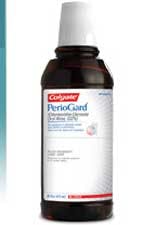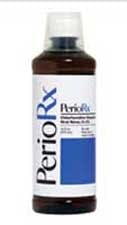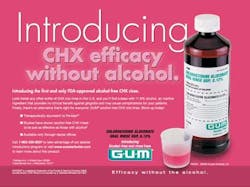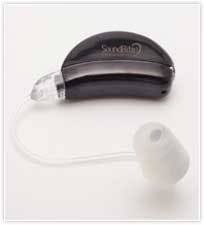Rinses for the control and prevention of plaque and gingivitis
Most people do not perform mechanical plaque removal sufficiently. Thus, antimicrobial or other mouthrinses that enhance daily self care may provide an effective means of removing or controlling bacterial plaque to limit gingivitis and periodontitis. (Barnett ML. The role of therapeutic antimicrobial mouthrinses in clinical practice: control of supragingival plaque and gingivitis. JADA 2003;134(6):699-704). This issue will focus on rinses for the control and prevention of plaque and gingivitis. Chlorhexidine, essential oils, cetylpyridinium chloride (CPC), and delmopinol will be highlighted.
Essential oil mouthrinses are antimicrobial rinses that contain phenol related essential oils. These include thymol, eucalyptol, menthol and methyl salicylate in a hydro-alcoholic vehicle. Most essential oils products contain alcohol as a solvent, but recently an essential oil mouthrinse was introduced with no alcohol. Essential oil mouthrinses act by rupturing the bacterial cell membrane, resulting in cell death, and preventing bacterial aggregation and recolonization. Essential oils can penetrate dental plaque biofilm killing pathogens on many surfaces, including the interdental areas. (Stoeken JE, Paraskevas S, & Van der Weijden GA. The Long-Term Effect of Mouth rinse Containing Essential Oils on Dental Plaque and Gingivitis: A Systematic Review. J of Periodontol. 2007; 78(7): 1218-1228.) A comparative study reviewed the efficacy of an essential oil antiseptic mouthrinse versus dental floss in controlling interproximal gingivitis. The conclusion was that in conjunction with professional care dental hygiene care and toothbrushing over six months, rinsing twice daily with an essential oil–containing mouthrinse was at least as good as flossing daily in reducing interproximal plaque and gingivitis. (Bauroth K, Charles CH, Mankodi SM, Simmons K, Zhao Q, and Kumar LD. The efficacy of an essential oil antiseptic mouthrinse vs. dental floss in controlling interproximal gingivitis. The Journal of the American Dental Association March 1, 2003 vol. 134 no. 3 359-365.) Cetylpyridinium Chloride (CPC)
Cetylpyridinium Chloride is a quaternary ammonium compound, demonstrating antiseptic properties. CPC is a broad spectrum antimicrobial agent that has been shown to prevent supragingival plaque formation and reducing gingivitis. (Blenman, T.V., Morrison, K.L., Tsau, G.J., Medina, A.L., & Gerlach, R.W. Practice implications with an alcohol-free, 0.07% cetylpyridinium chloride mouth rinse. Am J of Dent. 2005; 18: 29A-34A). As with chlorhexidine, side effects such as staining may occur with the use of CPC. As CPC is not as substantive as chlorhexidine, the side effects are not as great. (24. Haps S, Slot DE, Berchier CE, & Van der Weijden GA. The effect of cetylpyridinium chloride mouth rinses as adjuncts to tooth brushing on plaque and parameters on gingival inflammation: a systematic review. Int J Dent Hyg. 2008; 6:290-303).Delmopinol
Delmopinol hydrochloride 0.2%, a proprietary key ingredient that becomes strongly absorbed to the tooth and gum surface, creating a less-adhesive environment for bacteria and plaque. The product is currently the only oral rinse available approved by the FDA as a device (Class II Medical Device), whereas all other anti-plaque/anti-gingivitis rinses are classified as drugs. In the USA, you can find Delmopinol in the form of GUM PerioShield, clinically proven to help reduce plaque buildup and bleeding on probing up to 36%. (Lang, Hase, et al. Plaque formation and gingivitis after supervised mouthrinsing with 0.2% delmopinol hydrochloride, 0.2% chlorhexidine digluconate and placebo for 6 months. Oral Diseases 1998; Jun;4(2):105-113).Although Delmopinol protects against harmful bacteria, it does not directly kill bacteria. It breaks down the plaque and bad bacteria, making it easier to remove, while coating the teeth and gums to prevent additional plaque from sticking. As a result, continual use of this product helps maintain healthy, balanced microflora. The results of a study performed over a six-month period revealed an average 35% reduction in plaque and gingival bleeding in Delmopinol users, supporting product claims. (Addy, Moran, et al. Meta-analyses of studies of 0.2% delmopinol mouth rinse as an adjunct to gingival health and plaque control measures. J Clin Periodontol 2007 Jan;34(1):58-65).Delmopinol is proven effective for reducing plaque and treating gingivitis, whether or not it is used under supervision, confirmed by eight double-blind, randomized, placebo-controlled GCP studies. In five studies, subjects used Delmopinol under supervision, while three studies were unsupervised. The clinical studies report a 27% reduction in the number of bleeding sites versus the placebo group, and 23% less plaque than the placebo group. (Addy, Moran, et al. Meta-analyses of studies of 0.2% delmopinol mouth rinse as an adjunct to gingival health and plaque control measures. J Clin Periodontol 2007 Jan;34(1):58-65).Delmopinol has been available as GUM PerioShield Oral Health Rinse since August 2011, packaged in a 300ml bottle that provides a 15-day supply. For more information, visit www.sunstaramericas.com.Summary
Science supports the use of antiseptic mouthrinses as adjuncts to reduce plaque and gingivitis in all areas of the mouth, especially those areas not reached by toothbrushes, dental floss, or interdental cleaning devices. These products have been shown to have an effect on gingivitis, but not on periodontitis. Studies have found that rinsing can only accomplish its job in 21% of a 1-6mm periodontal pocket. (Southern EN, McCombs GB, Tolle SL, & Marinak K. The Comparative Effects of 0.12% Chlorhexidine and Herbal Oral Rinse on Dental Plaque-Induced Gingivitis. J Dent Hyg. 2006; 80 (1):1 – 3.). While all gingivitis does not proceed to become periodontitis, we know that gingivitis precedes periodontitis. By treating gingivitis, we may be able to decrease the numbers of periodontitis cases.Good news! Meta-Analysis: Chocolate Appears to Be Heart-Healthy
Higher levels of chocolate intake appear to be linked with a considerable reduction in the risk of cardiometabolic disorders. Researchers examined seven observational studies, including nearly 115,000 adult participants, that measured chocolate intake and cardiometabolic outcomes. Compared with the lowest level of chocolate consumption, the highest intake was associated with an approximately one third decrease in the risk for any cardiovascular disease or stroke. There was no benefit with regard to heart failure.The authors present a number of warnings about their conclusions. Most commercial preparations of chocolate have high levels of fat and sugar, which can contribute to obesity. They also point out that the present evidence only points to an association between chocolate and heart health. Further experimental studies are required to confirm a potentially beneficial effect of chocolate consumption. (Buitrago-Lopez A, Sanderson J, Johnson L, Warnakula S, Wood A, Di Angelantonio E, and Franco OH. Chocolate consumption and cardiometabolic disorders: systematic review and meta-analysis. BMJ 2011 Aug 29; 343:d4488).New Products
The SoundBite Hearing System
The SoundBite Hearing System is a novel hearing aid developed to transmit sound by way of teeth, and once it is in the mouth it is almost imperceptible. According to the company, Sonitus Medical is committed to providing advanced hearing solutions that hearing professionals such as Otologists, ENTs, and Audiologists can use to help their patients rejoin the conversation of life.
Ryan Newsome is the developer of this new app for the iPhone. Toothbrush Timer includes the following features: a Timer tells the user when and where to brush your teeth using recommended tips from the dentist or dental hygienist. The timer gives the user the ability to use the two minute interval (for electric toothbrushes) or adjustable intervals for traditional toothbrushes.
There is also a Toothbrush Tracker that alerts the user how long your toothbrush has been used. It also has a Dentist Reminder that reminds the user of their last dental visit. Version 1.2 includes local notifications for appointment reminders and updated retina icon. It was updated August 1, 2001, and is free of charge. For more information visit itunes.apple.com/us/app/toothbrush-timer/id307084494.
Note:
Kimberly-Clark Corp. Recalls Several Lots of KimVent Oral Care Kits with Chlorhexidine Gluconate Solution 0.12%
Kimberly-Clark Corp. and Avent Inc. has recalled several lots of KimVent Oral Care Kits with CHG (Chlorhexidine Gluconate) Solution 0.12%.
This recall for KimVent Oral Care Kits with CHG (Chlorhexidine Gluconate) Solution 0.12% was issued at a warehouse and pharmacy level only. The FDA and the manufacturer have determined that any recalled product that may have been dispensed to patients does not pose a significant health risk. If you use KimVent Oral Care Kit with CHG (Chlorhexidine Gluconate) Solution 0.12% and are concerned, you should speak to your dentist or pharmacist.
To view the FDA notice about this recall, please visit www.fda.gov/Safety/Recalls/EnforcementReports/ucm267575.htm.
Hi-Tech Pharmacal Recalls Single Lot of Chlorhexidine Gluconate Oral Rinse, 0.12%
Hi-Tech Pharmacal Co., Inc. has recalled a single lot of Chlorhexidine Gluconate Oral Rinse, 0.12%. Lot number 607247 has been recalled because routine testing found presence of solid undissolved material in these lots.
This recall for Chlorhexidine Gluconate Oral Rinse, 0.12% from Hi-Tech Pharmacal Co., Inc. was issued at a warehouse and pharmacy level only. The FDA and the manufacturer have determined that any recalled product that may have been dispensed to patients does not pose a significant health risk. If you use Chlorhexidine Gluconate Oral Rinse, 0.12% and are concerned, you should speak to your dentist.
To view the FDA notice about this recall, please visit www.fda.gov/Safety/Recalls/EnforcementReports/ucm267575.htm.
Sincerely,
Maria Perno Goldie, RDH, MS
To read previous RDH eVillage FOCUS introductions by Editorial Director Maria Perno Goldie, go to introductions.






